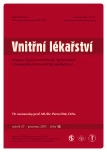The expected worldvide burden of oesophagus, stomach and colorectal cancers
Authors:
E. Geryk 1; T. Horváth 2; M. Konečný 3
Authors‘ workplace:
Fakultní nemocnice Brno, ředitel MUDr. Roman Kraus, MBA
1; Chirurgická klinika Lékařské fakulty MU a FN Brno, pracoviště Bohunice, přednosta prof. MUDr. Zdeněk Kala, CSc.
2; Geografický ústav Přírodovědecké fakulty MU Brno, ředitel ústavu doc. RNDr. Petr Dobrovolný, CSc.
3
Published in:
Vnitř Lék 2011; 57(12): 1006-1011
Category:
70th birthday of prof. MUDr. Petr Dítě, DrSc.
Overview
According database of Globocan 2008 of total 482 thousand worldwide new esophagel cancers are reported 16.9% cases in more developed and 83.1% in less developed regions, 6.9% in EU, 2.7% in the Eastern Europe; of total 989 thousand new stomach cancers are reported 27.8% in more developed and 72.2% in less developed regions, 8.4% in EU, 7.4% in the Eastern Europe; of total 1.235 milion new colorectal cancers are reported 59% cases in more developed and 41% in less developed regions, 27% in EU, 10.5% in the Eastern Europe. Of total 59,052 all neoplasms (without skin cancers) were reported 10,439 new cases of these three diagnoses in recent Czech Cancer Registry survey, higher by 595 cases than numbers based in Globocan 2008. However, according to these data the Czech males reached the 3rd order and females the 14th order by their cumulative risk of colorectal cancer in the world. The alarming worldwide numbers of new 4.771 milion of these three diagnoses and 3,137 thousands deaths from them, expected in 2030 with a higher risk in population of less developed regions require greater international cooperation and personal responsibility for improving the life-style, which would be failed the expected statistics.
Key words:
cancers of esophagus, stomach and colorectum – new cases and deaths – age distribution – expected numbers in selected regions of the world
Sources
1. Boyle P, Levin B (eds). World Cancer Report. Lyon: IARC 2008: 267.
2. Sadjadi A, Malekzadeh R, Derakhshan MH et al. Cancer occurrence in Ardabil: results of a population-based cancer registry from Iran. Int J Cancer 2003; 107: 113–118.
3. Saidi F, Sepehr A, Fahimi S et al. Oesophageal cancer among the Turkomans of northeast Iran. Br J Cancer 2000; 83: 1249–1254.
4. Li JY, Ershow AG, Chen ZJ et al. A case-control study of cancer of the esophagus and gastric cardia in Linxian. Int J Cancer 1989; 43: 755–761.
5. Ries LA, Melbert D, Krapcho M et al. SEER Cancer Statistics Review, 1975–2004. Bethesda, MD: National Cancer Institute, 2007.
6. Chandanos E, Lagergren J. Oestrogen and the enigmatic male predominance of gastric cancer. Eur J Cancer 2000; 44: 2397–2403.
7. IARC. WHO. Globocan 2008. Lyon: IARC. http://globocan.iarc.fr/.
8. Ferlay J, Shin, HR, Bray F et al. Estimates of worldwide burden of cancer in 2008: Globocan 2008. Int J. Cancer, 2010; 127, 12: 2893–2917.
9. ÚZIS ČR. Novotvary 2008 ČR. Zdravotnická statistika. Praha: ÚZIS ČR 2011: 262. www.uzis.cz
10. http://www.linkos.cz/.
11. Geryk E, Dítě P, Kozel J et al. Vícečetné nádory gastrointestinálního traktu v České republice v letech 1976–2005. Čes Slov Gastroent Hepatol 2010; 64: 12–21.
12. Geryk E, Dítě P, Sedláková L et al. Trend vícečetných nemelanomových nádorů kůže z pohledu jejich epidemiologie. Dermatologie pro praxi 2010; 4: 5–9.
13. Štampach R, Konečný K, Kubiček M et al. Dynamic cartographic methods for visualization of health statistics. In: Gartner G, Ortag F (eds). Cartography in Central and Eastern Europe. Berlin-Heidelberg: Springer-Verlag 2010: 431–442.
14. Konečný M, Reinhardt W (eds). Early warning and disaster management: the importance of geographic information. Int J Digital Earth 2010; 3: 217–220.
15. Konečný M, Geryk E, Kubíček P et al. Prevalence nádorů v České republice, 1989–2005–2015. Brno: PřF MU 2008: 69.
Labels
Diabetology Endocrinology Internal medicineArticle was published in
Internal Medicine

2011 Issue 12
Most read in this issue
- Neuroendocrine tumours of the upper gastrointestinal tract, characteristics and comparison of localization diagnostics
- Complications of endoscopic retrograde cholangiopancreatography and how to minimize them
- Aldosterone as an endogenous cardiovascular toxin and the options for its therapeutic management
- Do we need endoscopic sclerotherapy of oesophageal varices or the last turn off the light
